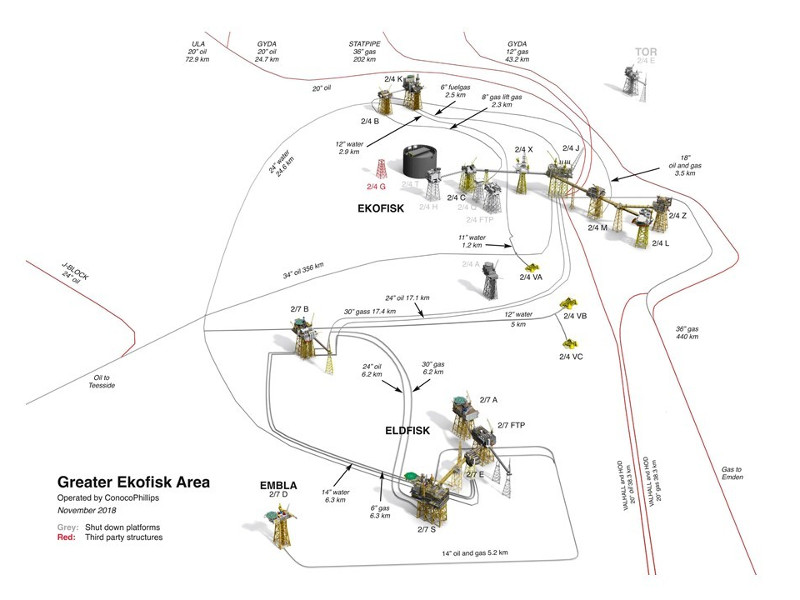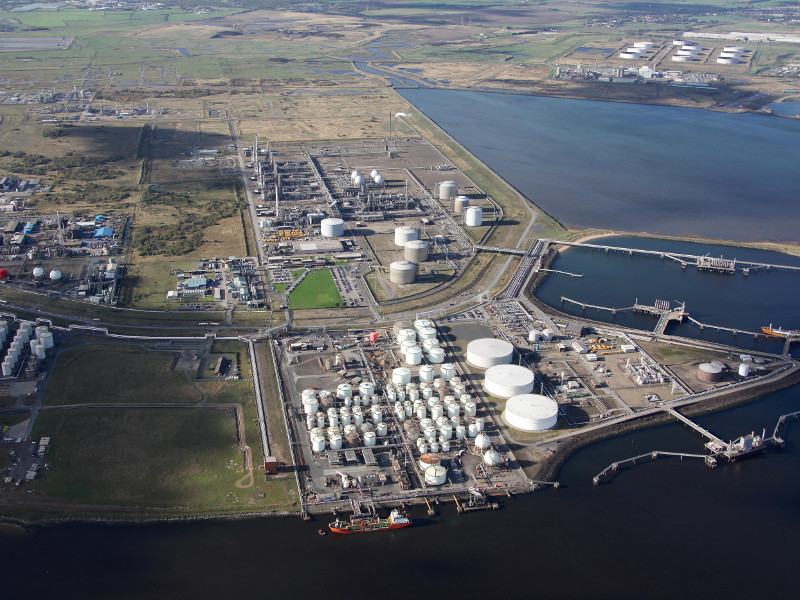The Greater Ekofisk area is located in the North Sea, approximately 300km south-west of Stavanger, Norway. It is one of the oldest operational field complexes on the Norwegian continental shelf, which comprises three fields namely Ekofisk, Eldfisk, and Embla.
The Greater Ekofisk area is jointly owned by ConocoPhillips Skandinavia (35.11%, operator), Total E&P Norge (39.9%), Vår Energi (12.39%), Equinor Energy (7.6%), and Petoro (5%). It currently includes 16 installations that are producing oil and gas from the three fields.
The average daily net production at the Greater Ekofisk area in 2018 was 60 million barrels of oil-equivalent per day (Mboed) including 51 million barrels per day (bpd) of liquids and 45 million cubic feet per day (Mcfd) of natural gas.
The latest project to be undertaken in the area is the redevelopment of the Tor field, which was closed in 2015. ConocoPhillips and partners in the Tor Unit submitted the Tor II development plan to the Ministry of Petroleum and Energy in July 2019. The new development will enable the Greater Ekofisk infrastructure to be utilised and operated until 2050.
Project Gallery
-

The Greater Ekofisk area is located offshore Stavanger in North Sea, Norway. Photo Credit: ConcoPhillips.
-

The Ekofisk Complex comprises nine platforms, which are connected through bridges. Photo Credit: ConcoPhillips.
-

Oil and gas produced from the area is transported onshore through the 354km-long Norpipe Oil Pipeline System. Photo Credit: ConcoPhillips.
Greater Ekofisk area geology details
The water depth in the Greater Ekofisk area is between 70m and 80m. The reservoir rock in the area has high porosity, but low permeability. The Ekofisk reservoir is composed of Cretacious (chalk) with a 300m-high oil column located at a depth of 3,000m below sea level.
The Eldfisk reservoir also consists of naturally fractured chalk (cretaceous) located at depths of between 2,700m-2,900m below sea level. The water depth at the Eldfisk site is less than 70m. The Embla field has a sandstone reservoir located at a depth of approximately 4,000m.
The seabed in the area has subsided over the years due to a drop in pressure in the underlying reservoirs. Efforts have been undertaken to protect the platforms as early as in 1985. The steel platforms of the Ekofisk Complex were jacked-up by 6m in 1987 and a protective barrier wall was installed around the Ekofisk Tank in 1989.
Ekofisk oil field development details
The Ekofisk field was discovered in late-1969 and started production in June 1971. The Ekofisk field has been developed in multiple stages since its discovery. Oil was loaded from buoys on the field in the first few years of production. Since 1975, oil and natural gas liquids are being transported through the 354km-long Norpipe Oil Pipeline System to Teesside, UK, while gas is being brought onshore through a pipeline to Emden, Germany.
The Ekofisk Complex comprises installations, which are connected with bridges on the central Ekofisk field. The initial field development started with Ekofisk A, Ekofisk B, and Ekofisk C production platforms, while the field currently has nine platforms.
As part of the Ekofisk Growth Project, the Ekofisk X wellhead platform and Ekofisk J process platform were installed in 1996 and 1998 respectively, while the Ekofisk M wellhead platform was installed in 2005.
The 2/4Z wellhead platform and the field centre were installed in 2013. The 2/4L accommodation platform, which is the world’s largest offshore living quarters, was commissioned in 2014.
Eldfisk oil field development details
The Eldfisk field is located in block 2/7, approximately 16km south of Ekofisk in the production license (PL) 018. Discovered in 1970 and approved for development in 1975, it is the second largest of the three fields in the Greater Ekofisk Area. It started production in 1979.
Eldfisk has a total of five production platforms producing oil from approximately 30 wells. Four of the production platforms, 2/7A, 2/7FTP, 2/7E, and 2/7S, are connected with bridges to form the Eldfisk Complex. The fifth platform, Eldfisk 2/7 Bravo, is located 6km north-west of the Eldfisk Complex.
The Eldfisk II project, which was launched in 2011, includes the installation of the 2/7S integrated platform and drilling of 40 production and injection wells. First production from the new project was commenced in January 2015. The expansion will extend the life of the Eldfisk field beyond 2028 and add 60,000bpd of oil production.
Embla oil field development details
The Embla oil field was discovered in 1988 and commenced production in 1993. It is the first high-pressure and high-temperature field to be developed in the area.
The field is installed with the Embla 2/7D normally unmanned production platform, which is located 24km south of the Ekofisk complex. Daily operations on the platform are run from a control room that is located at the Eldfisk Complex.
Oil and gas extracted at the platform are transported to the Eldfisk 2/7S platform through a 5.2km pipeline, where it is processed before further transport to Ekofisk 2/4J for export.
Tor II project details
The Tor II project includes the installation of a two-by-four slot subsea production system (SPS) with eight production wells. The new Greenfield facilities will be located approximately 1km west of the original Tor platform.
The SPS is planned to be connected to the Ekofisk Complex through multi-phase production and lift gas pipelines. Resource potential for the Tor II project is estimated to be in the range of approximately 60-70 million barrels of oil-equivalent (Mboe).
